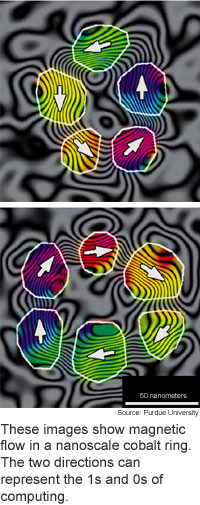
Nanorings promise big memory
Researchers are always looking for better
memory.
There are many projects aimed at making computer memory that holds
more information in smaller spaces, memory that allows data to be retrieved
more quickly, and memory that does not have to be refreshed so often.
Today's computers use dynamic random access memory, which must be constantly
refreshed, and therefore requires a constant stream of electricity in
order to retain information.
Researchers from Purdue University and the University of Cambridge
in England have found a way to cause magnetic cobalt nanoparticles to
spontaneously assemble into rings that are less than 100 nanometers across
-- or about one-tenth the diameter an E. coli bacterium.
Each ring contains a magnetic field that can flow either clockwise
or counter-clockwise. The two directions can represent the 1s and 0s of
computer information. Because the molecule is small, memory made from
it could hold a great deal information. And because the rings work magnetically,
they would not need power to retain information.
The magnetic fields are stable at room temperature. Also, unlike
most magnets, each ring keeps its magnetic field to itself, which is also
a good attribute for stable memory.
The method could be used to produce practical magnetic random-access
memory in 10 to 20 years, according to the researchers. The work appeared
in the November 3, 2003 issue of Angewandte Chemie International Edition.
Robot automates science
Chemicals map nanowire arrays
Badge controls displays
Neural-chaos team boosts security
Briefs:
Inkjet goes 3D
Nanotubes tied to silicon circuit
Micro tweezers have ice grip
Nanorings promise big memory
Protein orders semiconductor bits
Technique detects quantum state

Research Watch blog
View from the High Ground Q&A
How It Works
RSS Feeds:
News
Ad links:
Buy an ad link
Ad links: Clear History
Buy an ad link
|
TRN
Newswire and Headline Feeds for Web sites
|
© Copyright Technology Research News, LLC 2000-2010. All rights reserved.